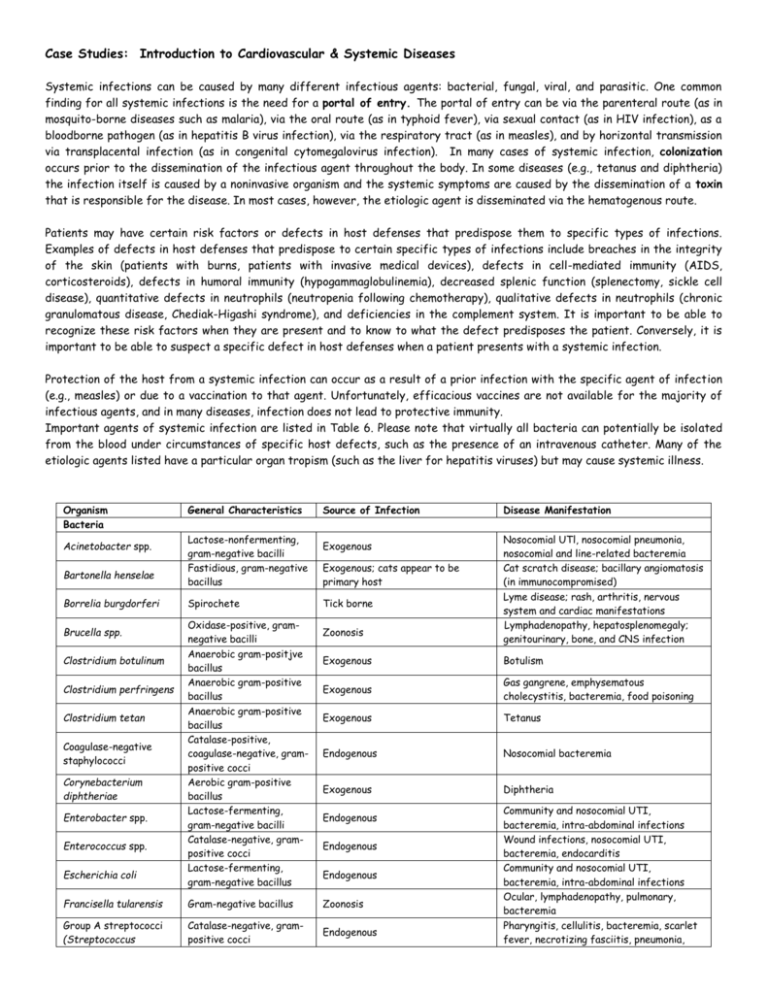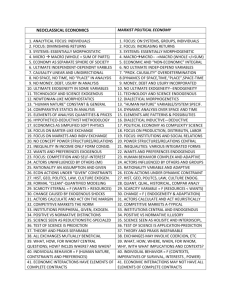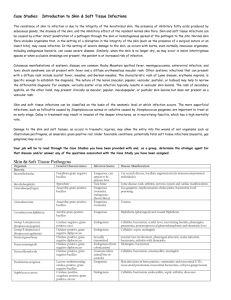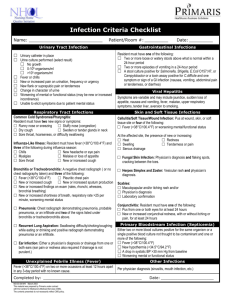Introduction to Cardiovascular & Systemic Diseases
advertisement

Case Studies: Introduction to Cardiovascular & Systemic Diseases Systemic infections can be caused by many different infectious agents: bacterial, fungal, viral, and parasitic. One common finding for all systemic infections is the need for a portal of entry. The portal of entry can be via the parenteral route (as in mosquito-borne diseases such as malaria), via the oral route (as in typhoid fever), via sexual contact (as in HIV infection), as a bloodborne pathogen (as in hepatitis B virus infection), via the respiratory tract (as in measles), and by horizontal transmission via transplacental infection (as in congenital cytomegalovirus infection). In many cases of systemic infection, colonization occurs prior to the dissemination of the infectious agent throughout the body. In some diseases (e.g., tetanus and diphtheria) the infection itself is caused by a noninvasive organism and the systemic symptoms are caused by the dissemination of a toxin that is responsible for the disease. In most cases, however, the etiologic agent is disseminated via the hematogenous route. Patients may have certain risk factors or defects in host defenses that predispose them to specific types of infections. Examples of defects in host defenses that predispose to certain specific types of infections include breaches in the integrity of the skin (patients with burns, patients with invasive medical devices), defects in cell-mediated immunity (AIDS, corticosteroids), defects in humoral immunity (hypogammaglobulinemia), decreased splenic function (splenectomy, sickle cell disease), quantitative defects in neutrophils (neutropenia following chemotherapy), qualitative defects in neutrophils (chronic granulomatous disease, Chediak-Higashi syndrome), and deficiencies in the complement system. It is important to be able to recognize these risk factors when they are present and to know to what the defect predisposes the patient. Conversely, it is important to be able to suspect a specific defect in host defenses when a patient presents with a systemic infection. Protection of the host from a systemic infection can occur as a result of a prior infection with the specific agent of infection (e.g., measles) or due to a vaccination to that agent. Unfortunately, efficacious vaccines are not available for the majority of infectious agents, and in many diseases, infection does not lead to protective immunity. Important agents of systemic infection are listed in Table 6. Please note that virtually all bacteria can potentially be isolated from the blood under circumstances of specific host defects, such as the presence of an intravenous catheter. Many of the etiologic agents listed have a particular organ tropism (such as the liver for hepatitis viruses) but may cause systemic illness. Organism Bacteria Acinetobacter spp. Bartonella henselae Borrelia burgdorferi Brucella spp. Clostridium botulinum Clostridium perfringens Clostridium tetan Coagulase-negative staphylococci Corynebacterium diphtheriae Enterobacter spp. Enterococcus spp. Escherichia coli General Characteristics Lactose-nonfermenting, gram-negative bacilli Fastidious, gram-negative bacillus Spirochete Oxidase-positive, gramnegative bacilli Anaerobic gram-positjve bacillus Anaerobic gram-positive bacillus Anaerobic gram-positive bacillus Catalase-positive, coagulase-negative, grampositive cocci Aerobic gram-positive bacillus Lactose-fermenting, gram-negative bacilli Catalase-negative, grampositive cocci Lactose-fermenting, gram-negative bacillus Source of Infection Exogenous Exogenous; cats appear to be primary host Tick borne Zoonosis Disease Manifestation Nosocomial UTl, nosocomial pneumonia, nosocomial and line-related bacteremia Cat scratch disease; bacillary angiomatosis (in immunocompromised) Lyme disease; rash, arthritis, nervous system and cardiac manifestations Lymphadenopathy, hepatosplenomegaly; genitourinary, bone, and CNS infection Exogenous Botulism Exogenous Gas gangrene, emphysematous cholecystitis, bacteremia, food poisoning Exogenous Tetanus Endogenous Nosocomial bacteremia Exogenous Diphtheria Endogenous Endogenous Endogenous Francisella tularensis Gram-negative bacillus Zoonosis Group A streptococci (Streptococcus Catalase-negative, grampositive cocci Endogenous Community and nosocomial UTI, bacteremia, intra-abdominal infections Wound infections, nosocomial UTI, bacteremia, endocarditis Community and nosocomial UTI, bacteremia, intra-abdominal infections Ocular, lymphadenopathy, pulmonary, bacteremia Pharyngitis, cellulitis, bacteremia, scarlet fever, necrotizing fasciitis, pneumonia, Organism pyogenes) General Characteristics Source of Infection Disease Manifestation poststreptococcal glomerulonephritis and rheumatic fever Group B streptococci (Streptococcus agalactiae) Catalase-negative, grampositive cocci Endogenous Sepsis, meningitis, cellulitis Klebsiella pneumoniae Lactose-fermenting, gram-negative bacillus Endogenous Community and nosocomial UTI, bacteremia, intra-abdominal infections Mycobacterium avium complex Acid-fast bacilli Exogenous Disseminated disease Mycobacterium tuberculosis Acid-fast bacillus Respiratory, may be exogenous (primary) or endogenous (reactivation) Pneumonia, extrapulmonary tuberculosis, miliary tuberculosis Endogenous (from colonization) Meningitis, bacteremia Zoonosis (often animal bite or scratch) Cellulitis, bacteremia, osteomyelitis, meningitis Community and nosocomial UTI, bacteremia Neisseria meningitidis Pasteurella multocida Proteus mirabilis Pseudomonas aeruginosa Oxidase-positive, gramnegative diplococcus Oxidase-positive, gramnegative bacillus Lactose-nonfermenting, gram-negative bacillus Lactose-nonfermenting, Oxidase-positive, gramnegative bacillus Endogenous Exogenous Rickettsia prowazekii Rickettsial organism Exogenous, lice to human Rickettsia rickettsii Exogenous, tick to human Viridans group streptococci Rickettsial organism Lactose-nonfermenting, gram-negative bacillus Catalase-positive, coagulase-positive, grampositive coccus Catalase-negative, grampositive coccus Spirochete (does not Gram stain) Catalase-negative, grampositive cocci Yersinia pestis Gram-negative bacillus Salmonella typhi Staphylococcus aureus Streptococcus pneumoniae Treponema pallidum Exogenous, human to human Endogenous Community and nosocomial UTI, nosocomial pneumonia, nosocomial bacteremia Epidemic typhus causes fever and disseminated intravascular coagulation. Rocky Mountain spotted fever Typhoid fever, bacteremia, intestinal disease Skin infections, bacteremia, endocarditis, septic arthritis, abscesses Direct sexual contact, vertical (mother to child) Community-acquired pneumonia, sinusitis, meningitis, bacteremia, endocarditis Primary, secondary, latent, and late syphilis; can affect any organ Endogenous Endocarditis Zoonosis; person to person in pneumonic form Lymphadenopathy (bubonic), pneumonia, bacteremia Endogenous Fungi Aspergillus spp. Molds with septate hyphae Exogenous Blastomyces dermatitidis Dimorphic mold Candida albicans Yeast, often germ tube positive Exogenous Endogenous Candida spp., non- albicans Yeasts, germ tube negative Endogenous Coccidioides immitis Dimorphic mold Exogenous Cryptococcus neoformans Encapsulated yeast Exogenous Histoplasma capsulatum Dimorphic mold Exogenous Zygomycetes Molds with aseptate hyphae Exogenous Pneumonia, sinusitis, external otitis, allergic processes, disseminated infection Pneumonia, meningitis, bone infection Thrush, vaginal yeast infection, diaper rash, esophagitis, nosocomial UTI, nosocomial bloodstream infection Thrush, vaginal yeast infection, nosocomial UTI, nosocomial bloodstream infection Pneumonia, meningitis, bone infection Meningitis, pneumonia, bloodstream infection Pneumonia, disseminated infection Pneumonia, sinusitis, invasive infection Viruses Dengue Virus Filoviruses Parasites Babesia microti Leishmania donovani Plasmodium spp. Strongyloides stercoralis Taenia solium Toxoplasma gondii Enveloped polyhedral capsid with singlestranded RNA Enveloped helical capsid with single-stranded RNA Exogenous (Aedes aegypti mosquito) Can be seen on peripheral blood smear Amastigotes in tissue touch preparation Can be seen on peripheral blood smear Nematode Exogenous (ticks) Babesiosis Exogenous (Phlebotomus fly) Kalaazar Exogenous (Anopheles mosquito) Malaria Exogenous; endogenous (autoinfection and hyperinfection) Exogenous Gastrointestinal, pulmonary (pneumonia, wheezing), disseminated in hyperinfection Gastrointestinal infection, cysticercosis (brain, muscles, other organs) Central nervous system, ocular, hepatic, pulmonary Tapeworm Protozoan Exogenous: unknown possible animal reservoir Exogenous; endogenous (reactivation) Dengue Fever; joint pain, fever, headache, rash, muscle pain, hemorrhagic fever/shock Hemorrhagic fever with high mortality. Case One This 39-year-old intravenous drug user (actively using cocaine on the date of admission) was admitted with cellulitis of the right arm after experiencing fevers for several weeks. He had been treated with outpatient antibiotics without relief of either associated chills or dizziness. Two sets of blood cultures were obtained on admission. A trans-thoracic echocardiogram demonstrated a 1cm vegetation on the ventral surface of the aortic valve. The patient left the hospital against medical advice, but was readmitted 2 days later for antimicrobial therapy. Past medical history was notable for multiple hospital admissions for both cellulitis and abscesses primarily involving the patient's arm. He had had multiple drug rehabilitation treatment attempts without success. Physical examination demonstrated a thin, unkempt man in no acute distress with multiple "needle track" marks on both his upper and lower extremities. No splinter hemorrhages or signs of embolic phenomena were noted on the extremities. Cardiac exam was notable for a grade II/VI systolic murmur best heard at the left sternal border. The spleen tip was palpable. The right arm had a 10-by-6-cm excoriated area with surrounding induration. Gram stain of an organism detected in both sets of the blood cultures obtained at admission. The organism grew in broth containing 6.5% NaCl, hydrolyzed esculin in the presence of bile (i.e., was bile esculin positive), and was catalase negative. 1. 2. 3. 4. 5. What type of infection does this patient have? What organisms frequently cause this type of infection in intravenous drug users (lVDUs)? What organism is causing his infection? How does intravenous drug use predispose the patient to this type of infections? Briefly describe the pathogenesis of this infection. Describe what other organs may be secondarily infected and the mechanism by which secondary infections occur. When considering antimicrobial therapy for this infection, what general strategy should be employed? What antimicrobial resistance problems have recently emerged involving this organism? What strategies have been employed to reduce the spread of these organisms? Case Two The patient was a 41-year-old man who had returned from Central Africa 12 days prior to his admission. He had been in Africa for approximately 7 months, working as a civil engineer on road building projects in Rwanda, Zaire, and Uganda. Seven days before admission, the patient noted the acute onset of fevers with chills as well as cough and myalgias. For the next 3 days he had episodes of fevers and chills approximately three times a day. After 3 days of fever, he sought care at a local urgent care center. He told the physician that he had just returned from Africa and had not taken malaria prophylaxis. He had a white blood cell count of 2,200/I and a platelet count of 102,OOO/I. No hematocrit was reported. A PPD test was placed. The patient was diagnosed as having bronchitis, treated with azithromycin, and instructed to return in 48 h to have his PPD read. On his return to have his PPD read, the patient was found to be hypotensive and had mental status changes. He was noted to be icteric. He was referred to the emergency room of the local hospital to "rule out hepatitis." A diagnosis was made in the hematology laboratory (blood stain below). At the time of his diagnosis, he was noted to have a hematocrit of 25%. After 24 h of antimicrobial and aggressive fluid therapy, he had a cardiopulmonary arrest. He was resuscitated. In the next 24 h, he developed acute respiratory distress syndrome and became progressively hypotensive. He was transferred to our hospital. On arrival, he was intubated and comatose. On physical examination, he was grossly icteric and tachycardic and was noted to be oozing bright red blood from his mouth and catheter sites. His laboratory tests were significant for a hematocrit of 23%, platelets of 39,OOO/I, prolonged bleeding times, and 3+ hemoglobin and 25 to 50 red blood cells in his urine. He was given fresh frozen plasma, platelets, and cryoprecipitate for his disseminated intravascular coagulation. Exchange transfusion was begun, with the patient receiving seven units of packed red blood cells. His condition continued to deteriorate, and he had a cardiac arrest from which he could not be resuscitated . 1. 2. 3. 4. With what organism was this patient infected? (Identify genus and species) Describe two complications associated with this organism, including the pertinent clinical findings seen in this case. What unique characteristic of this organism is important in producing these complications, and how did it contribute to producing these complications? Why do you think exchange transfusion was used as a therapeutic strategy in this patient? Discuss the problems associated with chemotherapy for infection with this organism. Case Three An extensive ongoing outbreak of typhus occurred in refugee camps in Rwanda, Burundi, and Zaire. For people in the camps, daily living was an immense hardship. Following the outbreak of civil war in 1993, over 760,000 refugees lived in camps under appalling conditions. Sanitation and clean water were hard to find, and disease was rampant. Besides typhus, outbreaks of typhoid fever, dysentery, and malaria also affected the refugee communities. The United Nations World Food Program distributed emergency rations to curb malnutrition. In some refugee camps, the people were required to work like a chain gang, collectively, on a single tract of land at a time. Those that left the camps were assumed to be rebel forces and could be shot by government soldiers. The civil war between the two main tribes for control of the government degraded into a tit-for-tat massacre of civilians. Against this background, a typhus epidemic emerged among the displaced population of Burundi. The outbreak may have begun among prisoners in a jail in N'Gozi in 1995. Clinical aspects of the disease included headache, chills, fever, prostration, confusion, photophobia, vomiting, and rash (seen below, generally starting on the trunk). There was a fatality rate of 15% among jail inmates. At the time, the disease was not recognized and was referred to as sutama. Reports of sutama among the civilian population date back to late 1995, and in association with body louse infestation, the disease subsequently swept across the higher and colder regions of the country. During a field study in February 1997, 102 refugees with sutama underwent clinical examinations and interviews. Serum samples were collected, and infesting body lice (pictured below) were removed. Analysis of blood sera by immunofluorescence microscopy found antibodies present against the causative agent, a small obligately intracellular pathogen (TEM below). Most of the 102 patients with sutama during initial assessment presented with typical manifestations of the disease. Up to September 1997, 45,558 cases were clinically diagnosed, most of which occurred in regions at an altitude of over 1,500 meters. 1. 2. 3. 4. 5. 6. What pathogen caused the typhus outbreak? How is the pathogen typically transmitted? How does the pathogen cause the bleeding under the skin that leads to the rash? What recommendations would you have made to treat this pathogen? Explain why. Why would the disease be most common in higher altitudes of eastern Africa? Why did the outbreak first appear among prisoners? Case Four A 24-year old, female graduate student in biology presented with exhaustion, weakness and a low grade fever. She was pale and showed poor ability to concentrate. Her history revealed that she had gradually become increasingly tired and weakened over the past two months. She had experienced low-grade fevers over the past month and felt she would need to drop out of her graduate program if she did not get this under control. She had had a severe strep throat about a year earlier and showed some signs of rheumatic fever at the time. She had had minor dental surgery about two months earlier. On examination, she had a temperature of 100°F. She had slightly enlarged cervical lymph nodes. She had a heart murmur, with abnormal valve sounds. Her ears, eyes and throat were clear. She had clear lungs and there were no significant findings in other systems. Organisms were isolated from her blood and plated on blood agar (Figure 1). Figure 1 1. 2. 3. 4. What would be your primary diagnosis of this patient? What agent do you think is causing this problem? How would you make a definite diagnosis? What are the possible outcomes when this disease is left untreated?






